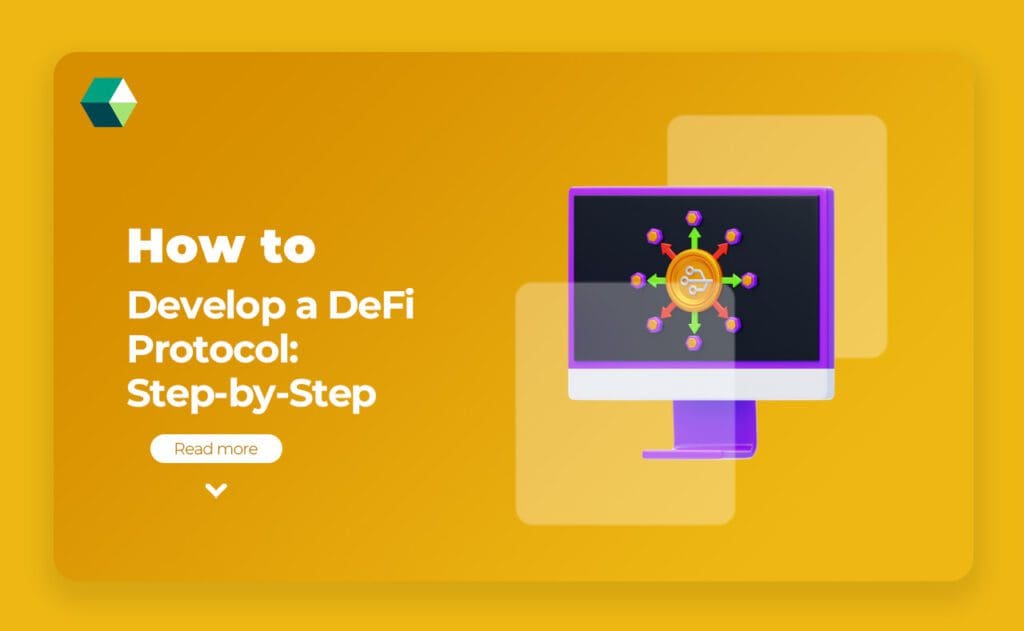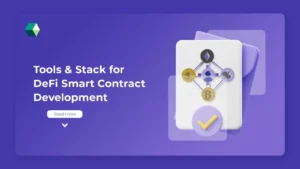
Decentralized Finance, or DeFi, is changing how we think about money. It allows people to lend, borrow, trade, and earn interest on their digital assets without going through traditional banks. This new way of handling money is growing quickly, and many people want to create their own DeFi platforms. In this guide, we will walk you through how to develop a DeFi protocol step by step. We’ll cover everything you need to know, including smart contracts, lending and borrowing, and what it takes to be a deFi protocol developer.
What is the DeFi Protocol?
Decentralized finance, or DeFi, refers to a system of financial applications built on Blockchain technology. Unlike traditional finance, which relies on banks and financial institutions, DeFi operates without intermediaries. This means that users can directly control their assets and make transactions through smart contracts—self-executing contracts with the agreement directly written into code.
DeFi protocols provide various financial services such as lending, borrowing, trading, and earning interest on digital assets. Some popular DeFi protocols include Aave, Compound, and Uniswap. These platforms allow users to lend their assets to others and earn interest or trade cryptocurrencies without the need for a centralized exchange. The key feature of DeFi is that it is open to anyone with an internet connection, providing greater accessibility and transparency in the financial world.
Benefits of Using DeFi Apps
Using DeFi apps has many good points that make them popular for people who want to manage their money in new ways. First, they are very easy to access. Anyone with an internet connection can use them without needing a bank account or going through long steps to verify their identity. This means that people all over the world can manage their money freely. Another big benefit is that DeFi apps give you complete control over your money. You can handle your assets without depending on banks or other middlemen, which lowers the risk of losing access to your funds. Plus, many DeFi protocols have lower fees compared to traditional financial services, making transactions cheaper.
Transparency is a key feature of DeFi apps. All transactions are recorded on a public blockchain, so anyone can see and verify them. This transparency makes the system trustworthy. Additionally, you can earn passive income through DeFi apps by lending your assets or providing liquidity, allowing you to earn interest or transaction fees. If you’re thinking about creating your own DeFi applications, working with a good DeFi protocol developer can help you build safe and innovative financial products that meet people’s needs.
The DeFi space is always growing and improving, leading to better services and new financial products for users. Overall, easy access, control over your money, lower costs, transparency, earning opportunities, and constant innovation make DeFi apps a great choice for many people looking for modern ways to manage their finances.
Step-by-Step Process for Developing a DeFi Protocol
Creating a defi (Decentralized Finance) protocol is an exciting venture that can offer innovative financial solutions. While the process may seem daunting, breaking it down into clear and actionable steps can make it manageable. Here’s a detailed guide to help you navigate the development of a successful DeFi protocol.
-
Define Your Idea
The first step in developing a DeFi protocol is to identify a clear and specific idea. Think deeply about the problems that exist in traditional finance or the current DeFi landscape. Ask yourself questions like: What inefficiencies can I address? Can I simplify lending and borrowing processes? Is there a way to enhance yield farming strategies? A well-defined idea will not only guide your development but also attract potential users who resonate with your solution.
-
Research the Market
Once you have a solid idea, conduct thorough market research. This involves analyzing existing DeFi platforms to see what features they offer, their user interfaces, and how they engage with their community. Look for strengths and weaknesses in competitors. For example, if a popular lending platform has high fees, you might consider creating a protocol with lower fees. Understanding the competitive landscape will help you position your product more effectively and identify opportunities for differentiation.
-
Choose a Blockchain
Selecting the right blockchain for your DeFi protocol is crucial. Ethereum is the most widely used platform due to its robust smart contract capabilities and large developer community. However, alternatives like Binance Smart Chain, Solana, and Avalanche offer unique benefits such as lower transaction fees and faster processing times. Evaluate the pros and cons of each blockchain in terms of scalability, transaction costs, and community support. Your choice will impact your protocol’s performance and user experience.
-
Plan Your Token
Tokens are a fundamental part of any DeFi protocol. They can serve various purposes, such as governance, utility, or rewards. Think about how you want your token to function within your ecosystem. For example, governance tokens allow users to vote on protocol changes, while utility tokens may grant access to specific services or discounts. Define the total supply of tokens, their distribution mechanisms, and any incentives for holding or using them. Additionally, consider implementing protocol fees in defi to optimize transaction costs based on network activity. A well-structured tokenomics model will encourage user engagement and investment.
-
Develop Smart Contracts
Smart contracts are the backbone of your DeFi protocol, automating the processes that enable users to interact with your platform. They can manage everything from transactions to governance. When developing smart contracts, focus on writing clear, efficient code that minimizes gas fees and enhances user experience. It’s essential to conduct thorough testing to identify and fix bugs before deployment. Tools like Truffle and Hardhat can assist you in developing and testing your contracts effectively.
-
Conduct Security Audits
Security is paramount in the DeFi space, where vulnerabilities can lead to significant financial losses. Before launching your protocol, it’s essential to have your smart contracts audited by experienced security professionals. They will review your code for potential vulnerabilities and recommend improvements. An audit can instill confidence in your users, knowing that their funds are secure. Investing in robust security measures early in development can save you from costly issues later on.
-
Create a User Interface
A user-friendly interface is key to attracting and retaining users. Design an intuitive dashboard that allows users to easily navigate your platform. Ensure that important features, such as lending, borrowing, and staking, are easily accessible. Utilize clear language and simple instructions to guide users through complex processes. The easier it is for users to interact with your protocol, the more likely they are to engage with it regularly.
-
Launch Your Protocol
After thorough testing and security audits, it’s time to launch your DeFi protocol on the selected blockchain. Pay close attention to the launch day to address any unexpected issues swiftly. Use social media and other marketing channels to announce your launch and generate excitement. Building anticipation before the launch can significantly increase user adoption and participation.
Future of Decentralized Finance Protocols
The future of decentralized finance (DeFi) looks very promising as more people seek new ways to manage their money. DeFi offers clear and easy options, and with advancements in technology and the rise of more blockchain networks, usage will expand across many areas. Improved cooperation between DeFi platforms will make moving money simpler, giving users more choices and allowing seamless transfers between services. A key part of this future is smart contracts—computer programs that automatically execute agreements without middlemen like banks—making transactions faster, safer, and more trustworthy.
As DeFi continues to grow, decentralized autonomous organizations (DAOs) will likely become more common. These user-driven communities allow people to participate in decision-making, giving them greater control over the services they use. With more users involved, clearer government regulations are expected, helping protect users while encouraging innovation in DeFi. These rules can create a safer environment without stifling creativity.
In summary, DeFi’s future points toward a more open and fair financial system where people worldwide can access services without traditional banks. As technology improves and participation grows, exciting new developments will emerge, making DeFi an accessible and trustworthy way to handle money.







